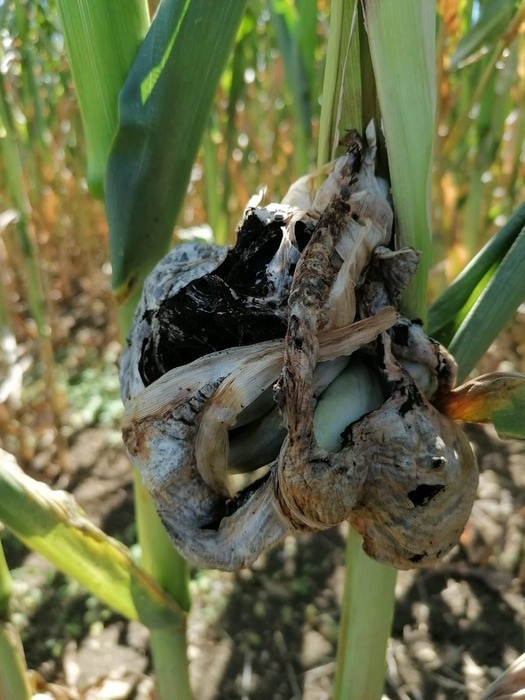Ustilago maydis attacks and reproduces in the aerial parts of the corn plant. At the location of the infection, massive tumor-like tissue growths frequently develop. The size of these galls can exceed that of a child’s skull. The effectors, which are chemicals secreted by the fungus, are what cause the growth.
 Maize plant infected with the fungus Ustilago maydis. Image Credit: © Mamoona Khan.
Maize plant infected with the fungus Ustilago maydis. Image Credit: © Mamoona Khan.
They interfere with the plant’s metabolism and weaken its defenses. In corn, they also encourage corn cell division and growth. They accomplish this by interfering with a plant signaling system that is controlled by the auxin hormone.
The fungus uses this auxin signaling pathway for its own purposes. This is because the huge growth of the tissue devours energy and resources that are then lacking for defense against Ustilago maydis. In addition, the fungus finds an ideal supply of nutrients in the growths and can multiply well there.”
Dr Armin Djamei, Professor and Head, Plant Pathology Department, INRES Institute, University of Bonn
Thus, the pathogen has a definite interest in the development of the distinctive galls.
Dr Djamei adds, “We therefore wanted to find out how the fungus promotes these proliferation processes. To do this, we searched for genetic material in the fungus that enables it to control the auxin signaling pathway of its host plant and thus its cell growth.”
At the Gregor Mendel Institute in Vienna, the intricate search got started seven years ago. The crop researcher carried on the work at the University of Bonn and the Leibniz Institute in Gatersleben.
Pathogen reprograms its host
He and his team were able to pinpoint five genes that the fungus employs to alter the auxin signaling pathway in the host plant. This group of five genes, designated Tip1 to Tip5, is referred to as a cluster: These five appear to be on successive pages of the Ustilago maydis genome, which is a huge encyclopedia.
The fungus needs genes, which function as building guides, to generate specific proteins.
“The proteins encoded by the five Tip genes can bind to a protein in the corn plant known to experts as Topless,” Dr Janos Bindics elaborates. He and his colleague Dr Mamoona Khan, a former employee of the Gregor Mendel Institute, carried out many of the important experiments for the study.
Topless is a key switch that disables a variety of plant signaling pathways. This suppression is overridden by the fungal effectors made by the five Tip genes, and they do this very specifically for signaling pathways that are advantageous to the fungus, such as the auxin-driven growth signaling pathway. Other Topless-controlled signaling pathways, however, are unaffected.
Figuratively speaking, the fungus acts with surgical precision. It accomplishes exactly what it needs to accomplish to best infect the corn plant.”
Dr Armin Djamei, Professor and Head, Plant Pathology Department, INRES Institute, University of Bonn
Insights for basic research
Numerous diseases disrupt the auxin signaling system of the hosts they infect. It is frequently unclear just how. It is possible that Topless is crucial to this procedure in other crops as well. The protein was formed many hundreds of millions of years ago, and since then, its primary function has rarely changed.
Therefore, it can be found in a similar form in all other terrestrial plants in addition to maize. For instance, the researchers were able to demonstrate that Ustilago maydis’ Tip effectors also disrupt other plant species’ auxin signaling pathways.
Therefore, the findings may contribute to a better understanding of how major plant diseases are infected. The findings are especially intriguing for fundamental research.
Through them, it will be possible for the first time to influence specific effects of the auxin signaling pathway in a very targeted manner and thus to elucidate the effect of these important plant hormones even more precisely.”
Dr Armin Djamei, Professor and Head, Plant Pathology Department, INRES Institute, University of Bonn
Armin Djamei is a member of the Transdisciplinary Research Area “Sustainable Futures” and the PhenoRob Cluster of Excellence at the University of Bonn.
Source:
Journal reference:
Bindics, J., et al. (2022) Many ways to TOPLESS – manipulation of plant auxin signalling by a cluster of fungal effectors. New Phytologist. doi.org/10.1111/nph.18315.